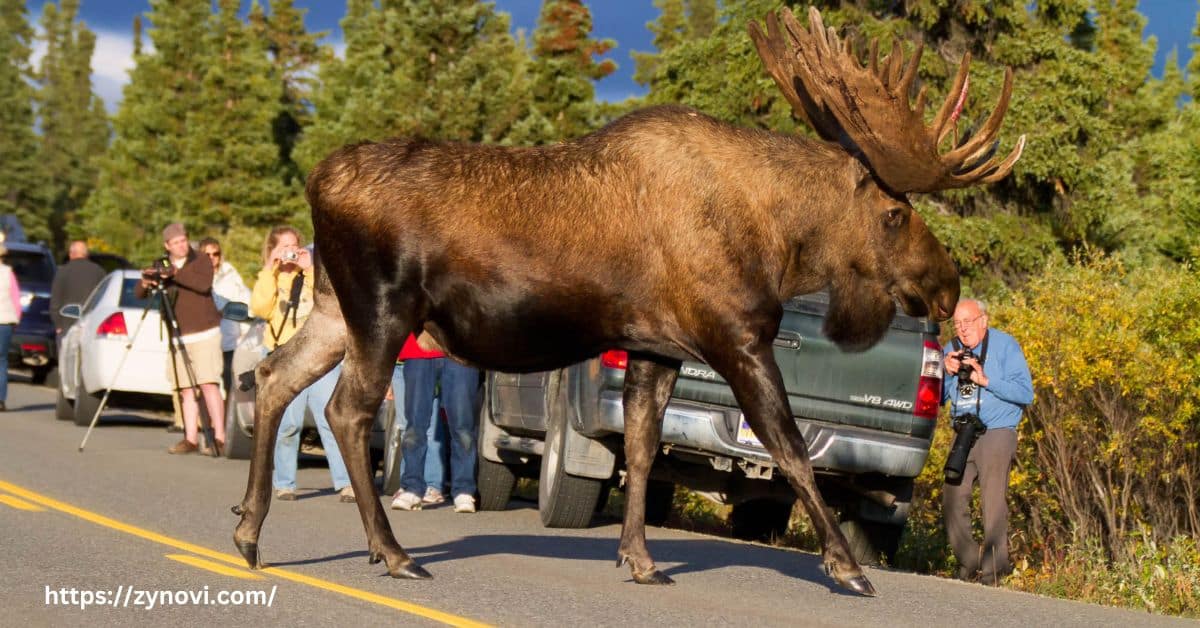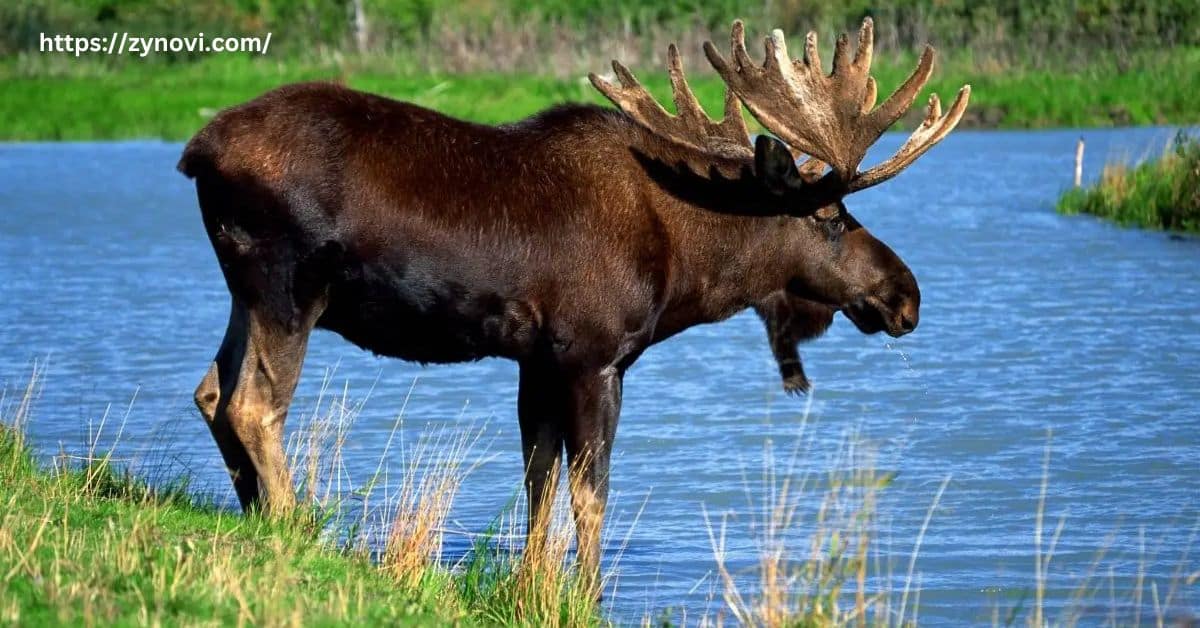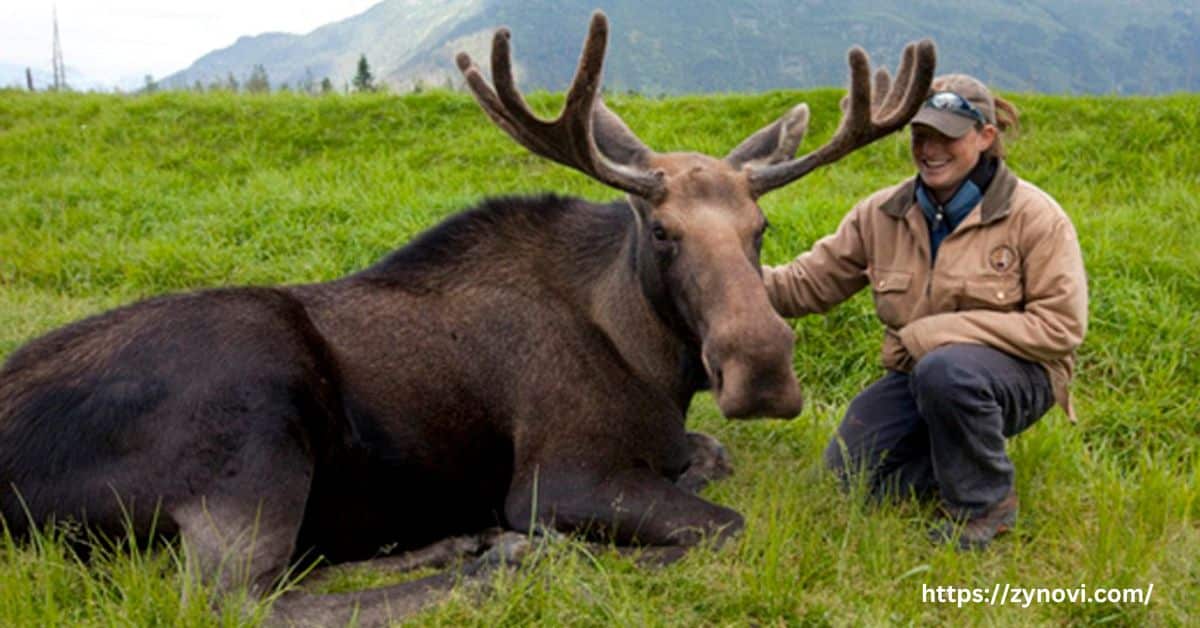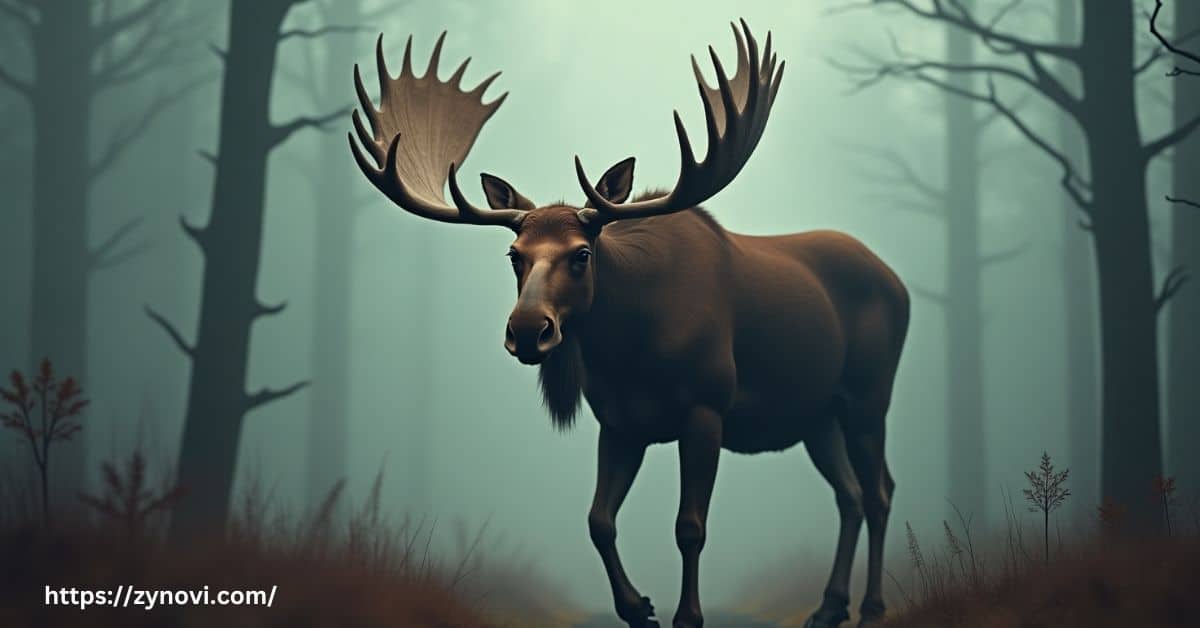Do Moose Attack Humans? Moose typically do not seek out humans, but they can attack if they feel threatened or provoked.
You might be surprised to learn that these massive creatures, often seen grazing peacefully in the wild, can actually pose a danger to humans. While moose are generally calm and solitary, certain situations can trigger defensive behavior that could turn threatening.
In this article, we’ll uncover the truth behind moose aggression and what you can do to stay safe when encountering one. Whether you’re hiking in the woods or just curious about these majestic animals, understanding their behavior is key to avoiding potentially dangerous situations. Keep reading to learn everything you need to know!
What Are Moose?
Moose, scientifically classified as Alces alces, are the largest members of the deer family and one of the most distinctive animals in the wild. Recognized for their towering height, which exceeds six feet at the shoulder, and their majestic antlers, moose are a symbol of wilderness and resilience.
These herbivorous giants thrive in boreal forests and temperate zones, primarily near lakes, rivers, and marshes where they feed on aquatic vegetation.
Their presence plays a vital role in maintaining ecological balance by influencing vegetation growth and supporting predator-prey dynamics.
General Overview of Moose
Physical Characteristics
| Aspect | Details |
|---|---|
| Height | Over six feet tall at the shoulder. |
| Weight | Bulls: 1,200–1,500 pounds; Cows: 800–1,300 pounds. |
| Antlers | Broad and flattened, spanning up to six feet wide (found only on males). |
| Throat Skin (“Bell”) | Unique dangling skin under the throat, present in both males and females. |
| Legs | Long and slender, ideal for deep snow and dense vegetation. |
| Swimming Ability | Can swim up to 10 miles and dive as deep as 18 feet to forage for aquatic plants. |
| Speed | Can sprint up to 35 mph to escape predators or respond to perceived threats. |
Subspecies and Global Presence
Moose are distributed across North America, Europe, and Asia, with notable subspecies including:
- Alaskan Moose: The largest moose subspecies, commonly found in Alaska and parts of Canada. Males can weigh up to 1,800 pounds, showcasing their immense size.
- Canadian Moose: Found across Canada and the northern United States, particularly in regions like Maine, Minnesota, and Montana. Known for their adaptability to both forested and open areas.
- Eurasian Moose: Native to northern Europe and Asia, this subspecies is smaller than its North American relatives but equally iconic in its habitats, including Russia and Scandinavia.
Why Do Moose Attack Humans?

Are moose dangerous? While moose are generally docile, their defensive behavior can make them dangerous under certain circumstances. Understanding the triggers for moose aggression is crucial for staying safe.
Instinctive Defensive Behavior
Moose, as prey animals, rely heavily on their flight-or-fight response to handle threats. When they feel cornered or perceive danger, they may charge aggressively, utilizing their powerful antlers or sharp hooves for self-defense.
Warning Signs
- Ears pinned back: This is a clear sign of agitation or aggression. When a moose flattens its ears against its head, it signals a readiness to confront the perceived threat.
- Raised hackles along the back: The fur on a moose’s back may stand on end as a visible indicator of heightened stress or defensive behavior, akin to how some predators display their alarm.
- Snorting or grunting: Loud, guttural sounds like snorting or grunting indicate the moose is highly alert and may be preparing to charge. These vocalizations serve as warnings to back off.
- Stomping the ground: A moose may repeatedly stomp its hooves on the ground as a demonstration of strength and intimidation. This is often accompanied by other aggressive signals, warning intruders to retreat immediately.
Mating Season Aggression (Rut)
The moose rut, taking place between September and October, is marked by significant behavioral changes, particularly among bulls. During this period, testosterone levels surge, driving bulls to become highly territorial and aggressive.
They are more likely to challenge other bulls in dramatic antler clashes to assert dominance and secure mates.
This heightened aggression isn’t limited to rivals bulls may perceive humans or other animals as threats, increasing the chances of dangerous encounters. Their unpredictable behavior during the rut makes maintaining a safe distance essential.
Calf Protection and Maternal Instincts
Mother moose, or cows, exhibit strong maternal instincts, making them highly protective of their calves, particularly during late spring and early summer when calves are most vulnerable.
Cows perceive potential threats quickly, whether from predators or humans, and won’t hesitate to charge defensively to protect their young.
Their size and power make these encounters dangerous, emphasizing the need to maintain a significant distance when observing a mother moose with her calves.
Human Interactions That Provoke Moose
Human activities can unintentionally agitate moose. Common triggers include:
Approaching too closely: Moose are naturally solitary and can feel threatened if humans get too close. Approaching within 50 feet can cause them to become defensive, especially if they are protecting their territory or calves.
Feeding moose: Feeding moose is highly discouraged as it disrupts their natural behavior and diet. Moose may begin to associate humans with food, which can make them more aggressive and less wary of human presence.
Startling them with loud noises or sudden movements: Moose are sensitive to loud sounds and sudden movements. Unexpected noise or quick actions can startle them, triggering a fight-or-flight response, potentially leading to a dangerous encounter.
Are Moose Attacks Dangerous?

Physical Threats from Moose
A charging moose can cause severe injuries or fatalities. Their antlers, used for defense and mating displays, can span over six feet. Additionally, moose use their sharp hooves to stomp predators or threats.
Comparison to Other Wildlife:
| Animal | Average Weight | Maximum Speed | Primary Threat |
|---|---|---|---|
| Moose | 1,200–1,500 lbs | 35 mph | Antlers, hooves |
| Bear | 600–1,000 lbs | 30 mph | Bites, claws |
| Bison | 1,800–2,000 lbs | 40 mph | Horns, charging |
Do Moose Attack Humans? Statistics about Moose Attacks
- In Alaska, moose injure more people annually than bears.
Moose are responsible for more injuries to humans in Alaska each year than bears, highlighting their potential danger when provoked or threatened. Many of these injuries occur due to sudden moose encounters while hiking or driving. - Fatal encounters are rare but have been documented, often resulting from human error or misjudgment of moose warning signs.
Although fatalities from moose attacks are uncommon, they do occur. Most fatal incidents are caused by humans misjudging the animal’s behavior or failing to recognize warning signs, such as pinned-back ears or stomping. - According to wildlife agencies, most moose attacks involve defensive behavior rather than predation.
Moose attacks are typically a result of defensive actions rather than predatory behavior. Moose do not hunt humans, but if they feel cornered, threatened, or are protecting their young, they may react aggressively to defend themselves.
How to Avoid Moose Attacks
Recognizing Warning Signs
Understanding moose warning signals can help prevent dangerous encounters:
- Ears pinned back
When a moose pins its ears back, it signals agitation or a potential threat. This is a clear warning sign that the animal is preparing to defend itself. - Direct, unbroken eye contact
A moose maintaining direct eye contact without looking away indicates it feels threatened or is sizing up a potential danger. - Hackles raised
Raised hackles along the moose’s back suggest the animal is on high alert and may charge if it feels provoked or cornered. - Snorting or stomping
Snorting and stomping are vocal and physical signals that the moose is agitated. These actions are meant to intimidate or warn off perceived threats.
Practical Tips for Moose Safety
- Maintain Distance: Stay at least 50 feet (15 meters) away from moose.
Keeping a safe distance is crucial for avoiding a confrontation. This gives the moose enough space to move freely without feeling cornered or threatened. - Avoid Feeding: This alters their natural behavior and increases human-wildlife conflict.
Feeding moose not only disrupts their natural foraging habits but can also encourage them to associate humans with food, increasing the risk of aggressive encounters. - Stay Calm: If a moose appears agitated, back away slowly without turning your back.
Maintaining calm is key. If you find yourself in close proximity to an upset moose, move away slowly while facing the animal, but avoid sudden movements that might trigger a charge. - Use Barriers: Position trees, rocks, or vehicles between yourself and the moose.
If a moose appears aggressive or too close for comfort, use any available natural barriers or vehicles to distance yourself from the animal. This can act as a shield in case the moose charges.
Seasonal Considerations
Moose behavior can vary significantly depending on the time of year. During the rut (mating season), typically from September to October, bulls are particularly aggressive due to heightened testosterone levels and territorial instincts.
Similarly, during the calving season in late spring and early summer, mother moose become highly protective of their young. It’s crucial to avoid areas with high moose activity during these periods to reduce the risk of encountering an aggressive moose.
Outdoor Preparedness
- Wear bright clothing: This helps you stay visible and reduces the chance of startling a moose.
- Carry bear spray: While designed for bears, bear spray can also be effective in deterring moose if they become aggressive.
- Avoid hiking at dawn or dusk: Moose are more active during these times, increasing the risk of encounters.
Do Moose Attack Humans? Real-Life Moose Attack Stories

Anecdotal Accounts
In Maine, a hiker had a close encounter with a moose when he unknowingly approached a cow and her calf. The moose, feeling threatened, charged at him.
The hiker managed to survive by quickly hiding behind a tree and remaining still until the moose lost interest and wandered off.
This incident highlights the importance of recognizing warning signs and maintaining a safe distance from moose, especially during the calving season.
Survivor Tips and Expert Recommendations
Quick Thinking: If a moose charges, use objects like trekking poles or backpacks to create a barrier or distract the animal.
Stay Down: If knocked over, curl into a ball to protect vital organs and remain as still as possible until the moose moves away.
Final Thoughts
Moose are truly awe-inspiring creatures, but their behavior can be unpredictable. Understanding their natural instincts and respecting their space is crucial for safe interactions. By recognizing warning signs of aggression and maintaining a respectful distance, humans can coexist with these magnificent animals.
Ultimately, preventing moose aggression relies on awareness and taking proactive steps to avoid disturbing or provoking them in their natural habitats.
FAQs
Are moose aggressive to people?
Moose are generally not aggressive but can become dangerous if they feel threatened, especially during mating season or when protecting their calves.
What should you do if you encounter a moose?
Maintain a safe distance, avoid sudden movements, and slowly back away to avoid provoking the moose.
Has a human ever ridden a moose?
While there are rare anecdotal reports, riding a moose is dangerous and not advisable due to their unpredictable behavior.
Can a human fight a moose?
Humans should not attempt to fight a moose; their size and strength make them formidable opponents, and it’s best to avoid confrontation.
Conclusion: Do Moose Attack Humans?
Moose are not naturally aggressive towards humans, but their size, strength, and defensive instincts can pose risks, especially if they feel threatened or provoked. Most moose attacks occur when humans unknowingly infringe upon their space, especially during mating season or when calves are present.
By staying informed, recognizing warning signs, and maintaining a safe distance, you can enjoy the presence of these majestic animals without putting yourself in harm’s way. Ultimately, respecting wildlife and their behaviors will foster a safer and more harmonious interaction.










